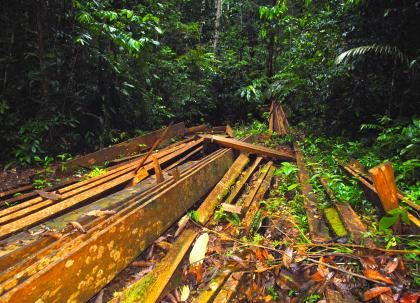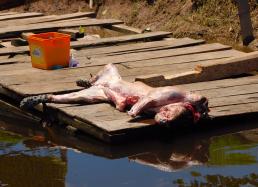8. Camp 4: Hunting, Logging, & A Tropical Parasite
Saludos from Camp 4, Güeppí! Our border crossing was surprisingly easy—we stopped for five minutes at the military post, and they waved us into Peru. This fourth site is along the lower Güeppí River, 12 kilometers from the junction with the Putumayo, and within the proposed Güeppí National Park. We established our camp 2.5 kilometers south of the river.
Our 22 kilometers of trails allowed us to explore a complex of low terraces, gently sloping low hills, a Mauritia palm swamp, and other low-lying flooded areas. In addition, one of our trails traversed a large, swampy, low-lying tangle of lianas, visible on the satellite image. This area was nearly impossible to walk through! Probably a large disturbance—a cloud downburst or a violent windstorm—knocked down a big patch of forest, and the vines are now re-colonizing the site.
This site had very obvious signs of human disturbance. For one, the area is crisscrossed by lumber trails and smaller hunting trails (see the photos above and below.) And while Doug was out birdwatching in the early morning, he encountered someone on our trails with a machete and a shotgun. In addition, there were obvious signs of active logging: cut trunks, drying planks of wood, and extraction trails. Much of this activity appears to be from the community of Tres Fronteras, an hour downstream by boat, who has used these forests for the last twenty years.
Despite these obvious signs of human impact, the wildlife was not skittish, and one of the rarest Amazonian mammals, the short-eared dog, was seen only at this site. Robin Foster sat down to eat some crackers, and all of sudden, he spotted a short-eared dog walking towards him! One of our good friends, Renata Leite Pitman, has been studying this incredibly elusive species in southeastern Peru. However, large primates were noticeably less common here than at Gueppicillo.
I’ll end this dispatch with everyone’s favorite lowland parasite: the botfly. One of the botanists, Jill Lopez, ended up with a botfly larva in her head. To see the removal process, check out our “Video Journal 5: Parasite Removal.”
Corine
Written October 24, 2007




